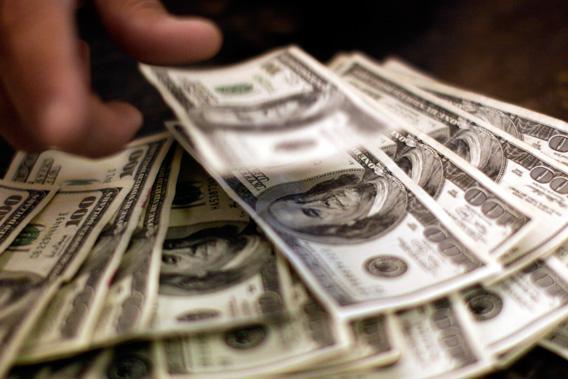America has grown desperate for smart ideas to revive a flagging economy. Sunday night in the Financial Times I read one of the most desperate: an op-ed by UCLA economist Roger Farmer arguing that the Federal Reserve should deliberately re-inflate a new asset price bubble to goose the economy. It’s a #slatepitch too far for me, but the conclusion is driven by two fairly reasonable arguments. One is that the economy continues to suffer from weak aggregate demand. The other is that reviving the economy through large-scale public works expenditures is likely to be ineffective and inefficient. The former is clearly correct—unemployment remains high and inflation low—and though the latter is somewhat controversial, I think it’s true. Farmer’s bottom line that he’d “prefer to see the creation of more private sector jobs, not more government jobs” is right on. But doing this by trying to engineer a stock market boom is insane. We should do something much simpler: print up a bunch of money and send it to American households.
Ben Bernanke himself famously argued years ago that a central bank should never run out of tools for fighting deflation and depression because, as a last resort, it could always drop cash out of helicopters. That would be fun to watch, obviously, but mailing checks would be a lot simpler. And even though it sounds a little insane, it becomes a more and more compelling idea the more you think about it.
The best thing about helicopter money is that it’s largely agnostic as to what lies at the root of our problems. As long as you think there’s some level of excess capacity in the economy, putting cash in the hands of households will help. Most obviously, if people had more money they’d buy more stuff. That means more jobs making, transporting, and selling the stuff. But not everyone would spend all of their helicopter money. Lots of families would use it to help pay off debts already accumulated, which would help speed the process by which we climb out of the debt hole of the boom years. Prosperous families without debts would just save a large share of their money. Increasing the size of the savings pool should drive borrowing costs down for firms that want to expand, while pushing up the value of stocks and other financial assets.
Compared to fiscal stimulus plans, this has many advantages. One is that it makes the budget deficit go down rather than up. Tax revenues will rise as economic activity speeds up, and the need to spend money on unemployment insurance and the like will fall if people get new jobs. (In many contexts, handing out money is an underrated tool for the long-term social good: Children in a Native American tribe that got revenue from a new casino had much better mental health than children whose families didn’t get the unexpected bonus.) It’s also really fast. Stimulus designers necessarily end up torn between a desire for speed and a desire to spend money in smart, low-waste, high-value ways. Cutting checks is all about speed, and it lets you consider well-designed investments on a separate track.
Compared to other monetary policy options, it’s simple, fair, and transparent. Almost nobody understands what “quantitative easing” is, and those who do are tired of trying to explain. As long as people are going to accuse the Fed of engaging in dastardly money-printing, it may as well reap the PR benefits of directly putting cash in people’s hands. The public’s worries that existing monetary programs are some kind of rip-off are overstated, but the existence of these worries limits the Fed’s ability to be aggressive. A simpler policy will be more sustainable.
One downside is, obviously, that if you print a lot of money you run the risk of sparking inflation. But here’s where existing Federal Reserve policy comes into play. The central bank has already promised that it will temporarily tolerate inflation as high as 2.5 percent at least until the unemployment rate falls below 6.5 percent. That’s a smart way of giving its current zero interest-rate policy more potency. But with inflation currently running a bit below 2 percent, it also means that there’s a cushion for additional stimulus. One way to read this is as a strong message to Congress that it should enact a stimulus program. But monetary stimulus works, too. Start printing money and mailing it to people. Say the checks will stop if inflation gets above 2.5 percent but otherwise will keep coming until the unemployment rate falls.
The only problem really worth worrying about is one Bernanke glossed over in his original helicopter paper—it’s probably illegal. But that just means we need to change the law. Not just for the current downturn, but for the next one. An issue that hasn’t gotten nearly enough attention is that the problem of the past five years—in which short-term interest rates fall to zero and “ordinary” monetary policy loses traction—is very likely to recur. It almost happened in the early aughts, after all. The combination of victory over inflation and slowing population growth means that even in normal times interest rates will be pretty low. Whenever we’re hit by a shock they’ll fall close to zero. Which means ordinary monetary policy of manipulating short-term interest rates actually can’t be our ordinary response to recessions. And if we’ve learned anything over the past several years, it’s that we can’t count on ad hoc congressional stimulus or quantitative easing programs to do the job.
We need a new strategy that can be taken off the shelf and implemented rapidly when needed. Helicopter money fits the bill perfectly. And even though it’s not monetary policy as traditionally designed, it fits the Federal Reserve’s mandate to stabilize prices and employment quite well. The ability to print money and directly give it to households is the tool we need, not just for today but for the next downturn.
